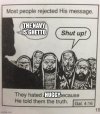Keep in mind the Air Force is rolling out these slick new ads ...
Don't let the Air Force's slick ad campaign lead you to believe their program is something that it's not.
... the Air Force puts a lot more money into shiny and slick ads, and feel good social media posts.
So you watched that video and this is your analysis. Well... OK, then.
What I saw was the 19th AF commander... a two star... speak to the AF pilot cadre to inform them on what is happening in the Training Command. Within the USAF pilot community, there's a lot of talk, concern, and questions about what UPT 2.5 is all about and how it is being implemented. Was it aimed at 20 year olds to get the into USAF pilot training? Maybe so. Who cares? I thought it was a good look at what the AF is doing. And if I was 20 years old, I'd appreciate seeing a pretty candid discussion on what to expect. Has the Dept of the Navy done something like that recently? If not, don't hate on the AF because your marketing sucks. Making a "slick video" to educate your "troops" ain't that tough.
Much of what I've heard over my 3+ decades in military flying squadrons was that senior leadership didn't communicate what they were doing. But here we have Maj Gen Wills (who I don't know from Adam) speaking about where this program came from... where it is going... why they are doing it... and addressing some of the questions about it. You know... information flow from a General officer. Honestly, flgator92, you have an issue with that? If so, I can't really help you.
This UPT 2.5 program will have many failures. I see that as part of the process when you are being innovative. Oh... I seem to recall many times over my career a complaint that there were leaders that wouldn't let us "think outside the box" for the sake of innovation, because "failure" would make them look bad. Maybe the UPT 2.5 folks are willing to accept that they won't get it right 100% of the time... but that the elements of success will be identified and integrated into USAF UPT. If your focus is that their use of in-cockpit camera footage while Maj Gen Wills was talking is just "shiny and slick" marketing, then once again, I can't help you.
In 2016, on my first flight in the 737, it was full of pax... I landed at night... via a circling/visual approach... to Kona... after 20 days of training. The technology to get me there was pretty good. It wasn't me with a plunger stuck to my floor, chair flying the event like I did in 1985-1986 in UPT. Can the AF maybe... just maybe?... find a way to do UPT training better than it was for me 35 years ago? I certainly hope so.
The AF is willing to spend a bunch on new training technologies. And you should be glad. Because since the AF will focus so heavily on that, the Dept of the Navy will hopefully be able to let the AF fund mucyh of it, and then roll in in 5 years and pick the successful items to integrate, having not spent a lot of their budget on the entire process. After all, Dept of the Navy has ships, Marines, SEAL's and a bunch of other stuff competing for their money.
The Navy stopped doing carrier quals for their student pilots in the T-28 in 1983. The T-45 was introduced 8 years later. T-28 to T-45 in 8 years??? Was the Navy "late to innovate"? Did someone just suddenly wake up and realize the T-28 needed to go? You can scoff at what the the AF is doing with UPT 2.5, but if you want to keep doing your Navy flight business the same way you've been doing it after 40 years, then you shouldn't become an entrepreneur in the civil sector. There's a lot that the Navy would probably like to change about their pilot training during a modernization enterprise. Navy Flag officers aren't stupid, nor are they beholden to things we did that are now outdated. They want the Navy to be efficient and better... and there is no doubt in my mind that this sort of thing is coming your way.
I'm guessing a lot of your comments are born of the Navy's culture of viewing the AF with derision. And that culture is fine... until it blinds you from things that can potentially help you become better. Hate the AF all you want... but don't hate the data they obtain by serious effort and funding... especially when it can help your and your Navy/Marine aviation cohorts.
BTW, a good friend of mine did an interservice transfer to the Dept of the Navy. I recall him telling me after a bunch of AF bashing in his ready room, he was asked "So what does the AF think of us?"
His reply: "We don't".

